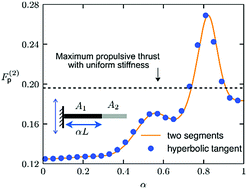Maximizing propulsive thrust of a driven filament at low Reynolds number via variable flexibility†
Abstract
At low Reynolds numbers the locomotive capability of a body can be dramatically hindered by the absence of inertia. In this work, we show how propulsive performance in this regime can be significantly enhanced by employing spatially varying flexibility. As a prototypical example, we consider the propulsive thrust generated by a filament periodically driven at one end. The rigid case leads to zero propulsion, as so constrained by Purcell's scallop theorem, while for uniform filaments there exists a bending stiffness maximizing the propulsive force at a given frequency; here we demonstrate explicitly how considerable further improvement can be achieved by simply varying the stiffness along the filament. The optimal flexibility distribution is strongly configuration-dependent: while increasing the flexibility towards the tail-end enhances the propulsion of a clamped filament, for a hinged filament decreasing the flexibility towards the tail-end is instead favorable. The results reveal new design principles for maximizing propulsion at low Reynolds numbers, potentially useful for developing synthetic micro-swimmers requiring large propulsive force for various biomedical applications.



 Please wait while we load your content...
Please wait while we load your content...